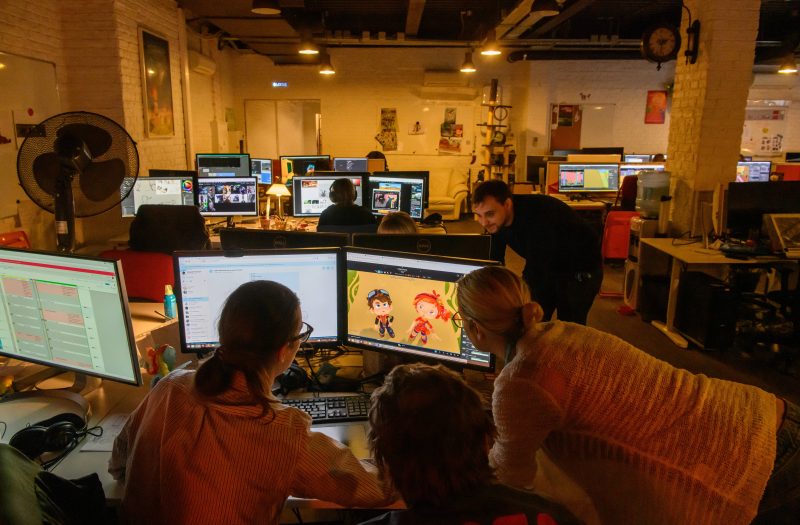Revamped Russian animation goes for global audiences
Russia’s state-owned animation company Parovoz is at the forefront of a resurgence of the country’s animation industry (Mladen ANTONOV)
Moscow (AFP) – In a slick Moscow loft, dozens of graphic designers peer at computers, compiling the latest scenes of “Fantasy Patrol”, a cartoon produced by Russia’s Parovoz animation studio.
With its Netflix contracts, state-owned Parovoz — which means locomotive in Russian — is at the forefront of a resurgence of the country’s animation industry.
But, for some observers, the revival comes at the expense of a tradition for innovation dating back to the Soviet-era heyday.
Russian authorities have invested heavily in the animation sector in recent years, after it, like others, was left in ruins following the breakup of the Soviet Union in 1991.
Parovoz is part of a state media holding and has grown from around 20 to 300 employees. Its animated series are shown in 55 countries.
Chief executive Anton Smetankin, who co-launched the studio in 2014, said it had “a product for every market”.
Last year, two Parovoz productions were bought by the US-based streaming service Netflix — one of them, “Leo and Tig”, is about the adventures of a tiger and leopard in Siberia.
“We have taken the best from the Russian school (of animation),” said artistic director Yevgeny Golovin.
“All of our films are full of kindness and can be watched by children of all ages.”
The studio also signed two contracts with China and had several of its projects dubbed and adapted for the Chinese market.
Today they are shown on four of China’s top streaming channels whose total users are estimated to number 1.5 billion a month.
– From the ashes –
Soviet animators won global repute for their creativity but the sector has seen mixed fortunes since then.
Soyuzmultfilm, a studio launched in the 1930s which made many of the Soviet Union’s animated greats, faced funding problems in the 1990s and lost control of its back catalogue.
In 2011, then prime minister Vladimir Putin stepped in to try to restore the Russian animation industry to its former glory.
By the early 2000s, Soyuzmultfilm had been reorganised and was again a state company.
The government returned the distribution rights for its classics back to the studio and invested about $14 million over five years.
– ‘Masha and the Bear’ effect –
But it is a cartoon series produced by a private Russian studio, Animaccord, that has proven a big international commercial hit.
Since 2009, “Masha and the Bear” about a mischievous little girl and an amicable, retired circus bear has been viewed dozens of billions of times on YouTube alone, as well as been broadcast in 100 countries, and has inspired several spin-offs.
“Our theme, which revolves around the relationship of a child and an adult, is universal,” Animaccord CEO Vladimir Gorbulya told AFP.
“There is a good amount of humour and things to reflect upon for viewers of both age categories.”
Encouraged by the global success of the computer-animated duo, the Russian government has continued to boost support for the industry, announcing massive subsidies and, in 2017, tax reductions.
“There is a desire to make sure our children look at animated films with our national cultural codes, our mentality, our language and culture,” said Irina Mastusova, who heads the Russian animation association.
She noted that the Russian animation sector was still relatively up-and-coming, with around 3,000 employees.
– Commercial ‘propaganda’ ? –
The government attention is in line with Moscow’s increasing efforts to inject conservative, patriotic values avowed by the Kremlin into the cultural sphere.
Smetankin, of the Parovoz studio, conceded that animation was part of Russia’s drive for “soft power” abroad, a form of cultural diplomacy to explain Moscow’s view of the world, especially at a time of tensions with the West.
In November, Britain’s The Times newspaper cited experts in a report who called “Masha and the Bear” a form of “propaganda”, saying that “feisty but plucky” Masha “punches above her weight” while the bear’s sanguine character painted Russia in a positive light.
The studio rejected the depiction, pointing out that the cartoon was made without government funding.
Larisa Malyukova, a culture reporter for the independent Novaya Gazeta newspaper, said that government support prioritised commercial success, rather than innovative and poetic projects of the kind that made Soviet animators famous.
“The culture ministry pays less and less attention to original animation,” she said.
“This worries artists, since this is what, at least in Russia, is a laboratory that creates new talent.”
Joel Chapron, a Russian film expert for the Cannes Festival for two decades, agreed that Russia’s animation was changing.
“Before, the legacy of animation in Russia was associated with prodigies and big names. Today, nobody knows who the authors are.”
Disclaimer: Validity of the above story is for 7 Days from original date of publishing. Source: AFP.


